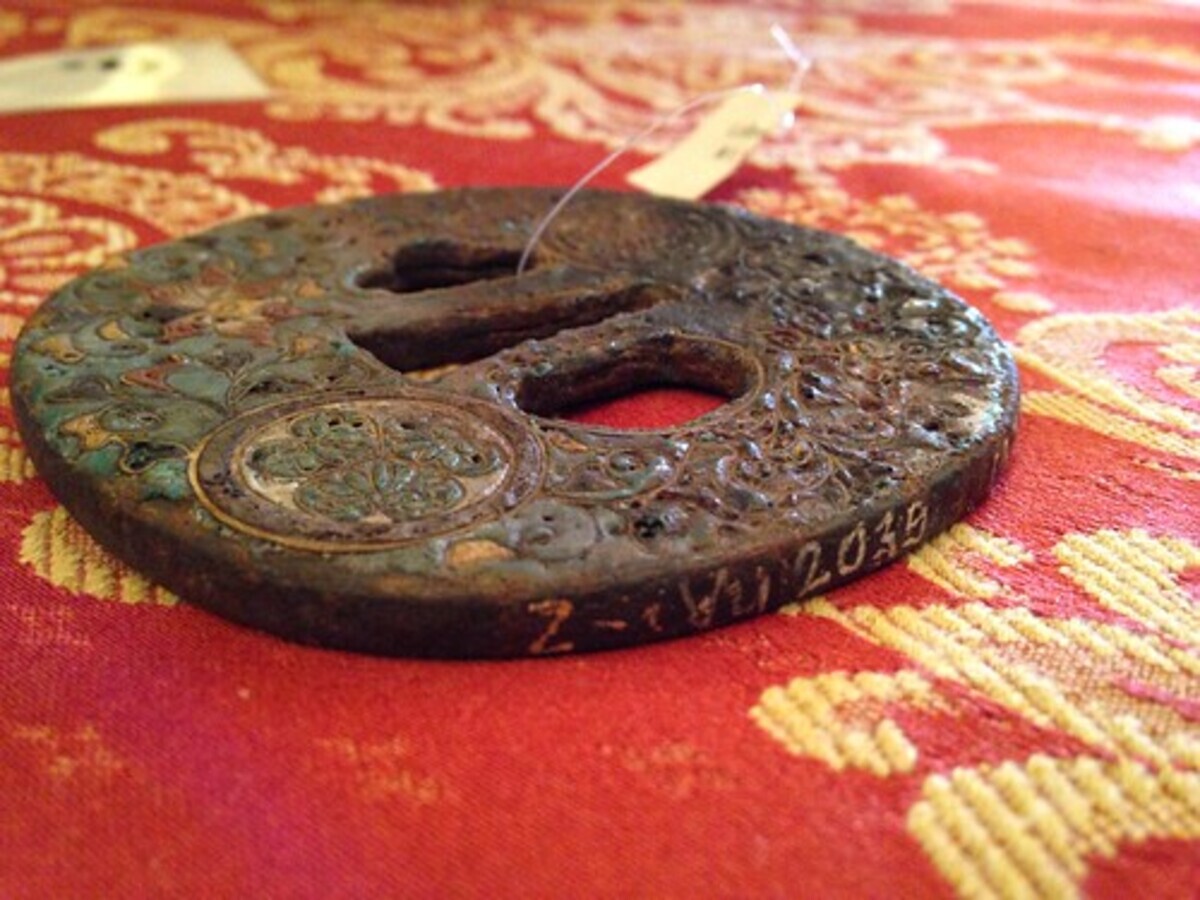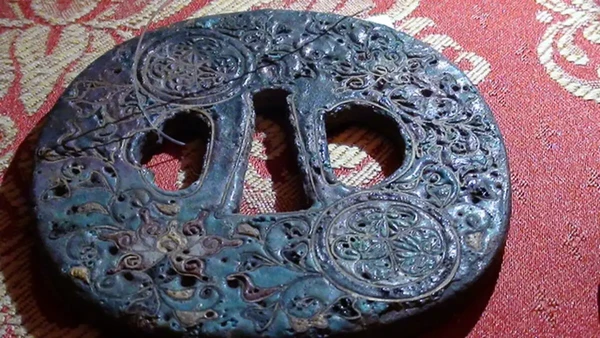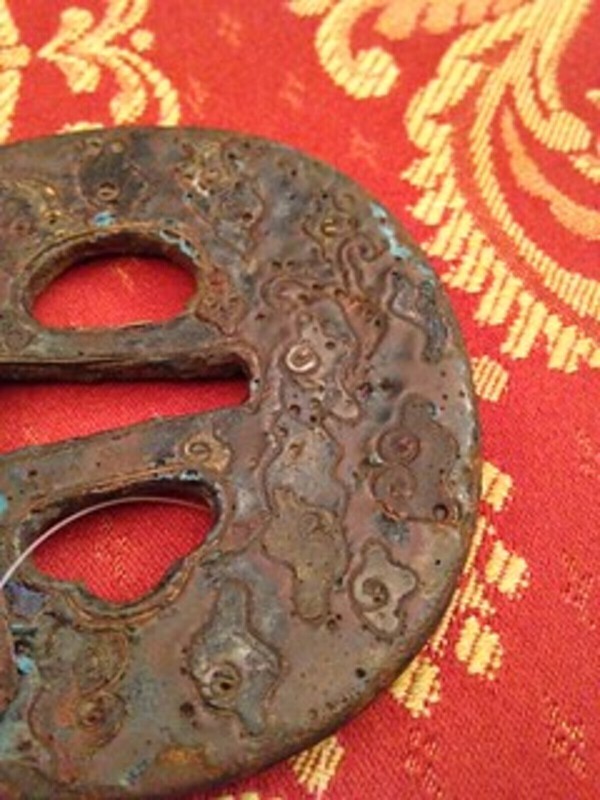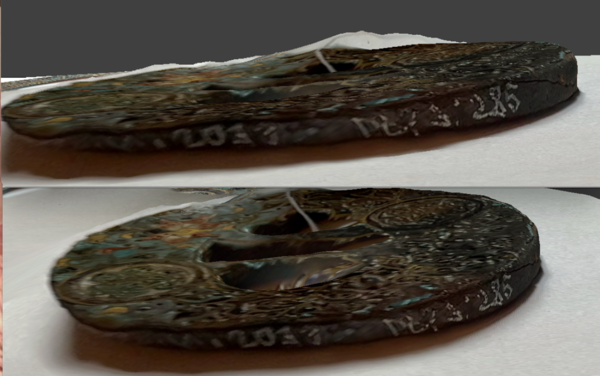
Hannah
Members-
Posts
22 -
Joined
-
Last visited
Content Type
Profiles
Forums
Events
Store
Downloads
Gallery
Everything posted by Hannah
-
Hi, thank you so much. You said that the tsuba in question and this one are far too similar to not be related. But this would mean that both tsubas would be related to the Tokugawa Gosanke which I thought we established that it was far too low of a quality to have been. Just a little confused Hannah
-
If it had been in this museum, how would it have gotten out? Did the museum sell objects to people or might it have got lost? H.
-
-
The ones with the red background were taken about 10 years ago by a previous group that did this tsuba, the others by an iPad. The reason they look bad is due to the 3D camera we had to use. Still trying to find the lost images, those were taken with the normal camera.
-
If I have them on my desktop, how can I do that? I want to make this as accessible as possible so that the photos are seen on the post. Thanks
-
Haha! Sorry, the files didn't fit. Would the layering be copper on one side and iron on the other? What might that suggest? It's magnetic (which copper is not) yet a lot of people are suggesting that it is copper. If it were only two layers, one would have to be made of a magnetic material (iron). H
-
No, unfortunately, we only had one chance to see the tsuba, so we took plenty of pictures. Unfortunately, we seem to have lost a few of them, but I'm working on recovering them. I've gone through the ones we have and zoomed in to get a better look. The quality isn't great, but it appears that the inside surface of the tsuba is covered in bumps and there doesn't seem to be any smooth part. You can check out the zoomed-in pictures here https://drive.google...Mwd1o?usp=drive_link H.
-
Would it have been possible for the tsuba to have been made in Nagasaki? Or was it just a port exporting goods? I also found this: From 1641 onwards, Dutch and Chinese ships were allowed entry to a Japanese port, the designated port being Nagasaki. Dutch traders resided on the artificial island of Dejima and were the only Westerners to be able to trade with Japan.
-
We had a magnet about 2 cm in diameter and the magnetic pull was strong all around but it was strongest on the side (where the writing is)
-
The tsuba seems to have a magnetic pull, specifically from the sides. Although I believe the surface is made of copper, which is not magnetic, the sides may have more traces of iron, hence the slight magnetic effect.
-
Yep, it's iron and copper.
-
Hi, I've added 17 new pictures with red backgrounds. You can find them at https://drive.google...Tflsiyq?usp=sharing. Unfortunately, there wasn't enough space to put them here. Hope you can see it better! Best, Hannah
-
Let's take the scenario that the fire damage had happened after its departure from Japan. Could it have been in use or as decor/collections in Japan? @Brian mentioned that it doesn't look like it was made for serious use, so what might it have been doing in Japan for almost 200 years? H.
-
I thought that due to the poor quality of the cloisonne, it was made in the 1600's?
-
The damage would come from the shipwreck? So why would someone buy a damaged Tsuba? Do collectors care whether they are damaged, in good condition, or good quality?
-
What a shame. So there is no actual way to figure out whether it was just an Aoi-mon or for the Tokugawa shogunate except for the quality. There is some white writing on the sides, would that have been written by the maker or by the Dutch as identification? It also doesn't make sense to me why the Dutch would want to export a burnt and cracked tsuba. The numbers are -2-VM2039 P---285 (We used "-" for anything that we couldn't read)
-
Would there be a reason for someone to have a tsuba with the Matsudaira/Tokugawa mon if they weren't part of that family? When we look at the sides of the tsuba, on one end there is some writing in white, and on the other, there is a huge crack. In that case, the tsuba could have gotten the burn and the crack in the kiln, meaning it was never actually used. Would there be a way to see that? If the tsuba had been used, would we see scratches on the inside of the nakago-ana or any other wear-and-tear to suggest it would have been used? Thanks, H
-
Thank you, that makes a lot more sense. According to this website about the Hirata School, they can't find any pieces of work with each maker's inscription because pieces of work for the shogun family must not be inscribed. When comparing our tsuba to another inscribed (right now I'm looking at the tsuba inscribed by Yoshitane), I can see that the inscription is of his name next to the nakago-ana. Based on the information I stated above (and your previous response) since our tsuba doesn't have an inscription like this, it was meant for the Tokugawa shogunate. I also can't seem to find where the school was/is located. Thanks, Hannah
-
Hi Colin, Jean and Piers, From what I understand, you believe that the reason half of the tsuba appears "colour-less" or with its original bronze colour is due to a fire? Which would mean that originally it was fully coloured, right? Also after researching more about cloisonne, it says "The renaissance of Japanese cloisonné manufacture is credited to one Kaji Tsunekichi (1803–83) of Nagoya in Owari province". That would imply that our tsuba's cloisonne had to have been "manufactured" towards the end of the Edo Period (1603-1868). Would this also mean it had to have been made in Owari by Kaji Tsunekichi? Thank you so much, Hannah
-
Hi Brian, thank you so much, I think the reason the nakago-ana looks distorted is because of the 3D model camera we took the photographs with. On the other side of the tsuba, there are no pointy sides, though I am unsure whether that is what you are talking about. Thank you do much, Hannah
-
Hi everyone! I am an eighth-grade student at the International School of Prague. Recently, our Social Studies class introduced a new project known as the Curator Challenge. Each of us received an undisclosed artefact from the Lobkowicz family collections. Our objective is to identify our assigned artefact and contemplate its placement in a museum exhibit. Additionally, we're tasked with delving into its historical context by researching its origins, purpose, and societal significance. This entails understanding who crafted it, why it was made, its intended use, and how it reflects the beliefs and practices of its era. Ultimately, we'll write an essay analyzing the historical importance of the artefact and its implications on the societal values of its time. To excel in this task, our group must collaborate effectively as museum curators. Our group was allocated what we believe to be a tsuba. So far we know that: Dejima (Japanese for “exit island"), was an artificial island off Nagasaki that served as a trading post for the Dutch (1641–1854). For 220 years, it was the central conduit for foreign trade and cultural exchange with Japan during the isolationist Edo period (1600–1869), and the only Japanese territory open to Westerners. Until the mid-19th century, the Dutch were the only Westerners with exclusive access to Japanese goods, and, to a lesser extent, society and culture. We believe our tsuba is from the Edo Period and that it was brought over to Amsterdam by the Dutch East India Company. We know is often considered the first truly multinational corporation. From the 17th to the 18th century, VOC acted on behalf of European governments. Their initial goal was to develop trade links for prized items. In 1610, VOC gained a foothold in Batavia (Indonesia / Dutch East Indies) and conquered most of the island of Ceylon (Sri Lanka) by 1640, establishing the stronghold of Galle. As Cape Town (South Africa) was only founded in 1652 we know that our tsuba can’t have travelled to Europe from before that date. Cape Town was a crucial stage for the long Europe-Asia voyage. Different designs symbolise different things. A tsuba is like a crest or coat of arms of a family. A family would have several tsubas that are the same. It is the most decorated part of the Japanese sword, usually bearing engravings of the clan coats of arms or crests, and occasionally purely ornamental motifs that often elevate the tsuba to the condition of genuine works of art. It is the most decorated part of the Japanese sword, usually bearing engravings of the clan coats of arms or crests, and occasionally purely ornamental motifs that often elevate the tsuba to the condition of genuine works of art. Many tsubas are signed by the maker on the seppa-dai (the area around the nakago ana). When mounted, the tsuba seppa-dai is covered by seppa (metal spacers) and the signature (mei) is not visible. According to Trukatana, during the Edo period, the Tsuba was a symbol of cultural identity as it represented the warrior spirit as well as artistic sensibilities and craftsmanship. Those are all parts of Japan's cultural identity. Furthermore, as per the University of Michigan Museum of Art, family crests were important in samurai classes. That is important because the Tsuba showed the owner's political connections, bloodline, and marriage relationships. Therefore, they would represent one’s social status or value. A Tsuba can highlight naturalistic scenes, and secular stories, which are tales that are not directly directed to religion. Additionally, this object can give an insight into religious symbolism which shows someone's beliefs. Now as it stands, we are trying to figure out where the tsuba originated IN Japan as well as where the tsuba was after it arrived in Amsterdam. We are looking into "cabinets of curiosities", which were collections of objects whose categorical boundaries were (in the Renaissance) yet to be defined, and trying to see whether our tsuba was in one of them. So far, we have not had any piece of our timeline after it would have landed in Amsterdam. We would like to know whether there are any clues or paths we could go down to figure this out. We are also trying to find out where it originated. As of now, we are looking at the designs on the tsuba as well as the writing on the side. So far, none of it has been of much help as we can't seem to find geographical clues. However, we are trying to find out whether it might have belonged to a prominent Japanese family. If you have ideas or clues we could go down to figure out anything related to origins, makers, the people it belonged to, or a timeline of its travels, please feel free to reply or guide me to another post on here. Below are photos of both sides and the writing, (sorry for the link but they wouldn't all fit here) Thank you so much Hannah https://drive.google...cTflsiyq?usp=sharing












